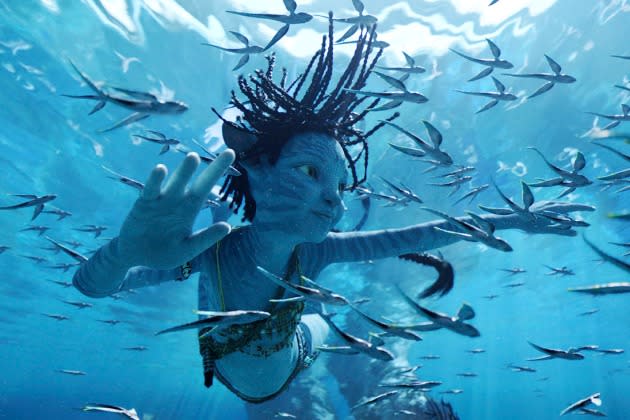‘Avatar: The Way of Water’ Team Raced to Create 1,065 Delivery Versions for Theaters
- Oops!Something went wrong.Please try again later.

The herculean effort to make James Cameron’s groundbreaking Avatar: The Way of Water and deliver the movie to theaters around the world for its Dec. 16 day-and-date release was the subject of a day-long series of panels and presentations, Tuesday at the HPA (Hollywood Professional Association) Tech Retreat.
A sold-out crowd of 750 Hollywood tech leaders, developers and suppliers got a look at the unprecedented initiative to deliver the movie to theaters undertaken by Disney, 20th Century Studios, Cameron and producer Jon Landau’s Lightstorm Entertainment, and their suppliers.
More from The Hollywood Reporter
Box Office Milestone: 'Avatar 2' Sinks 'Titanic' to Rank as No. 3 Pic of All Time
'Avatar 2' Sweeps Visual Effects Society Awards Feature Competition
Euro Box Office Tops $7B in 2022, Still Well Below Pre-Pandemic Levels
With digital cinema, theaters vary greatly in their screening capabilities, and Cameron and Landau were bullish about delivering the best possible experience to each individual theater. In the case of Avatar: The Way of Water, this involved the creation of a whopping 1,065 unique delivery versions of the movie. This unheard-of number of deliverables included combinations of 2D, 3D, HDR, 4K, varying light levels, aspect ratios, a high frame rate of 48 frames per second, a range of audio formats, 51 languages supported with subtitles and 28 languages supported by dubbing.
For some context, the typical Marvel tentpole involves roughly 500 deliverables, which is already a very high number. Kim Beresford, vp integrated planning and motion pictures operations at Walt Disney Studios, explained that in order to meet the delivery date, the movie was effectively divided into 15 reels, allowing the team to begin creating delivery elements even before the completed 3-hour, 12-minute movie was locked. Roughly 800 versions of the movie were QC’ed (quality control reviewed) in the final five days before release.
“We didn’t have the movie together until about 16 days before the release date,” Beresford explained. “We moved reel by reel because we couldn’t wait.” In all, she reported that this meant creating 6,338 portions of the DCPs (digital cinema package, which is the digital equivalent of a film print).
“We had to turn our operation into a 24/7 support model,” reported Walt Disney Studios vp technology Mark Arana of the unconventional approach. The team invented a new system to create (including subtitling, dubbing and quality control) and track all of the versions and portions of the versions over multiple vendors (among them, Deluxe, Pixelogic and Eikon), around the world. It also involved development of a new DCP mastering tool, enabling mastering in the cloud.
“The thing I’m most proud of was the level of collaboration and innovation,” summed up Beresford. Added Deluxe’s Rich Welch, “I think this has changed everything about the process from camera to screening.”
Asked if a 3D or 48fps home release could be on the horizon, Beresford replied, “I think there are roadmaps … even if that might not be available today.”
The day kicked off with a remote presentation from The Way of Water cinematographer Russell Carpenter (who won an Oscar for Cameron’s Titanic) and a live panel of guests from the production. Carpenter took viewers through the development of the camera system, production workflow and lighting techniques. He also walked guests through the complex ways that they combined the real and the synthetic, evening in the same shots. The development process started in 2013. Carpenter added that at the time, Cameron effectively told him, “We don’t know how we are going to make it, but we’ll know how we’ll make it after we make it.” Added the DP: “He’s an explorer, and he likes a challenge.”
Avatar was lensed with Sony’s Venice cameras (with Cameron’s 3D rigs for live action or built with underwater housing for shooting in the tank.) This included use of the Sony Rialto system that separated the sensor from the rest of the camera system, giving users more flexibility. Simon Marsh, Sony’s product manager for the Venice camera and Rialto, reported that Sony’s first meeting with Lightstorm was held in 2017 and the camera technology was ready in mid-2018. (In an apparent reference to Top Gun: Maverick, he added that another “very big movie” also used the Rialto system, but “really everything started with Avatar.”)
As to the presentation itself, a cutting-edge 4K, 3D and 48 frame per second (with DCI-compliant picture) digital projection system was installed in the ballroom of the Westin Rancho Mirage for the program. The installation, which began last Friday for Tuesday’s presentation, included a pair of Christie 4K 25,000 lumens laser projectors with a RealD 3D system.
The day included a keynote conversation between Jon Landau and The Hollywood Reporter’s Carolyn Giardina.
